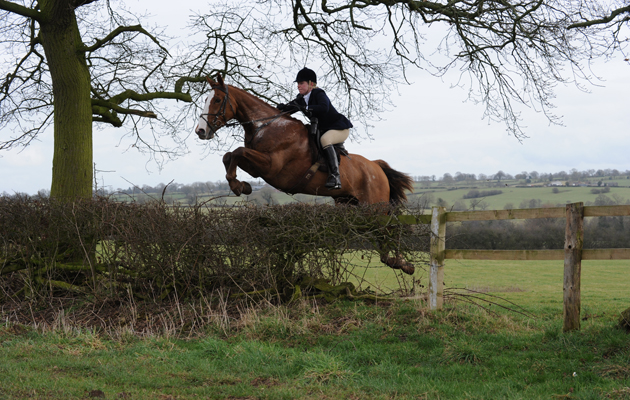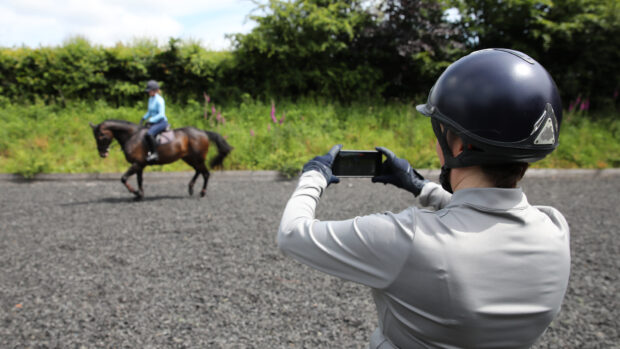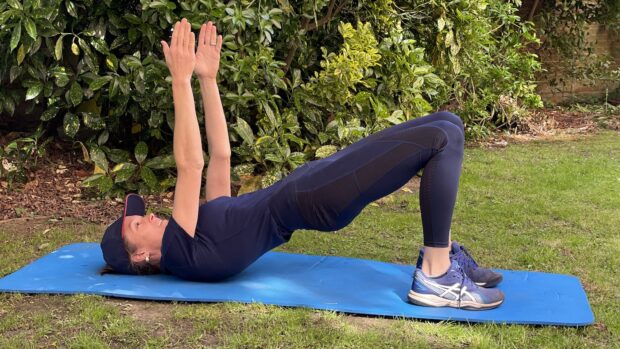If your body is aching and tired after your day in the saddle, take a look at Equestrian Pilates’ Sue Gould-Wright’s key Pilates exercises for horse riders to keep you riding fit.
Even a few hours in the saddle can leave your body tired and aching – the leg muscles work hard, the lower back can ache if your core isn’t working correctly and if you have a strong horse you can end up feeling like you have wrestled a rhino by the time you get back to the yard. Pilates can help ensure your body is working correctly, preventing the ache in the first place.
Pilates for horse riders: some exercises to try
Engage your core

Think of pulling your tummy in gently, as if you were trying to pull the area behind the zip of your breeches inwards.
To get your core muscles working correctly think of pulling your tummy in gently, as if you were trying to pull the area behind the zip of your breeches inwards to the back waistband of your breeches. That will stop you overusing other stomach muscles higher up that act to tip forwards. Check as you are doing it that you don’t clench your bottom muscles.
Related: check out these exercises to improve your core stability.
Loosen your legs
The legs are your shock absorbers as you travel across country on your horse so you need to keep them supple. Ideally you should do these before and after you ride but just when you remember is better than nothing.

Back of the leg stretch
For the back of your legs: Stand at arm’s length facing a wall or door, put your hands on the wall and then step back with your right leg, keep the right leg straight as you press the heel to the floor bending the left knee at the same time; you should feel a stretch all the way up the right leg. You should have a line from your ear, shoulder, hip and ankle — avoid arching your back and sticking your bottom in the air. The larger the step back, the greater the stretch but remember, it should be a stretch not a screaming pain. Repeat on the other side.
For the front of your legs: Stand side-on to a table or stable surface using the hand nearest the table to support yourself if you feel unbalanced. Bend your outside knee taking the heel up towards your backside. Hold onto the foot (or whatever you can reach) and, keeping nice and upright, try to push the outside leg backwards until you feel a stretch in the front of the thigh. Repeat on the other side.
Balance
At some point when you’re out on a ride you might need to dismount – or your horse may decide that you need to – and getting on from a gate or a log as elegantly as possible is the name of the game. So practise standing on one leg whenever you get a chance — boiling the kettle, waiting for water buckets to fill or brushing your teeth… the possibilities are endless. Make sure you work on both legs as you never know when you might have to mount from the ‘wrong’ side. Once you can balance perfectly, try bending and straightening the leg you are balancing on to strengthen it even more, but do ensure you are keeping your pelvis and upper body upright throughout — it should just be the knee, hip and ankle moving.
Related: check out these exercises to improve your balance.
Whoa there!
If you find yourself cantering along a tad faster than you would like, hanging on with the arms and shoulders will make them ache for days and isn’t particularly effective – you need to get the bigger muscles of your back involved. Engage your core (this will support your lower back) and then think of drawing your underarm down towards your waist. This does take practice so do it off the horse first, it has the added benefit of correcting rounded shoulders and making you look great too. Once you and your horse have tried this, you can use it as your half-halt, too, as it is a much smoother, less ‘argumentative’ feeling for the horse.
Pass the flask

Keep your pelvis still when turning.
Most horses will move from a change of weight in the saddle so when turning to someone behind you it’s best to keep your pelvis still, only rotating through the body. Start the movement from the base of the skull — imagine you are trying to take a sneaky look someone’s new horse – turn ever so slightly through the neck, looking behind you out of the corner of your eye. Now nosiness has got the better of you so you turn fully through the neck, then allowing the shoulders to turn and then keep turning, one bone at time. Try not to lean back as you do this as this may put pressure on the lower back.
Bums of steel!
When you are riding up out of the saddle for long periods the muscles in the backside are working as hard as those in the legs. You need to keep these muscles from becoming overly tight as they can be responsible for lower back pain and sciatic-type pains; the best way to do this is to find yourself a tennis ball and a wall or bolted stable door. With your back to the wall, put the tennis ball between your butt and the wall, roughly where the top of your back pocket would be and then gently lean into the ball. Rub your backside with the ball like your horse would scratch his bottom on tree or post – there will be areas that are tight and sore, just keep the pressure bearable and it should ease the longer you do it. Repeat on the other buttock.
Article photographs courtesy of J.A. Allen from Equestrian Pilates – Schooling for the Rider by Sue Gould-Wright.
You might also be interested in:
Improve your core stability to help improve your riding in 2023

How to improve your balance to help boost your riding skills

Subscribe to Horse & Hound magazine today – and enjoy unlimited website access all year round
Horse & Hound magazine, out every Thursday, is packed with all the latest news and reports, as well as interviews, specials, nostalgia, vet and training advice. Find how you can enjoy the magazine delivered to your door every week, plus options to upgrade your subscription to access our online service that brings you breaking news and reports as well as other benefits.



